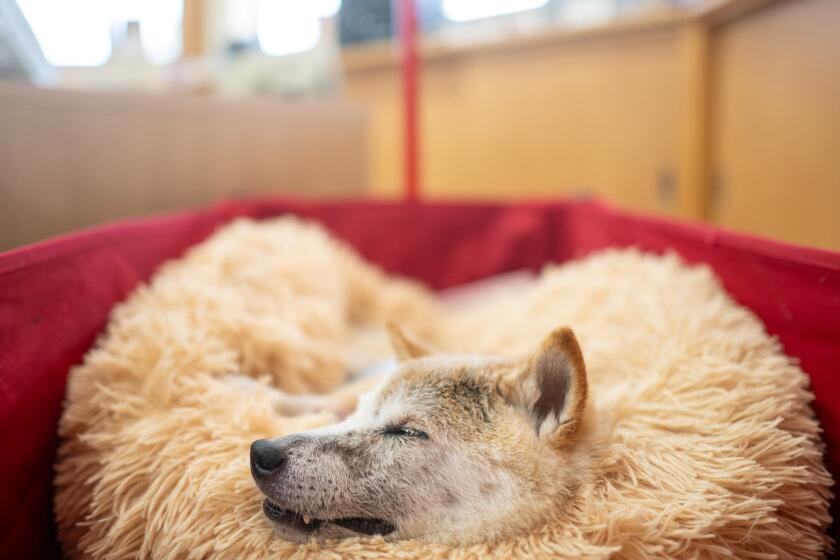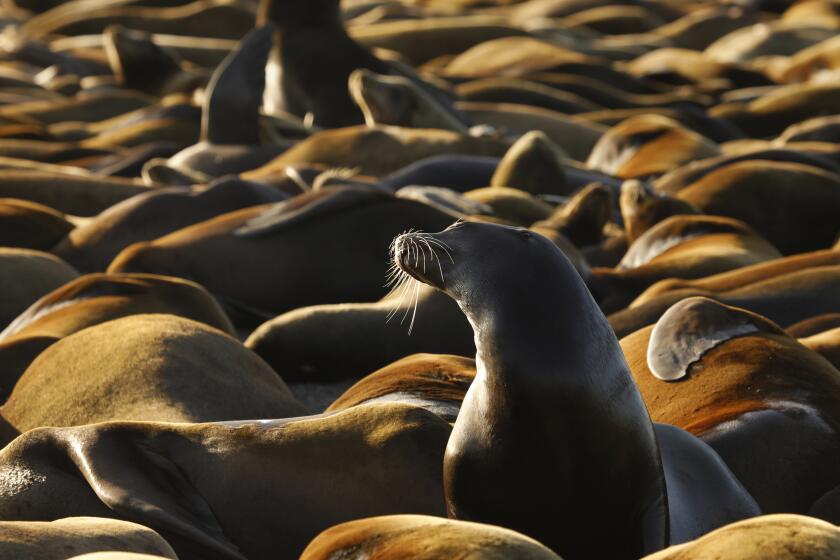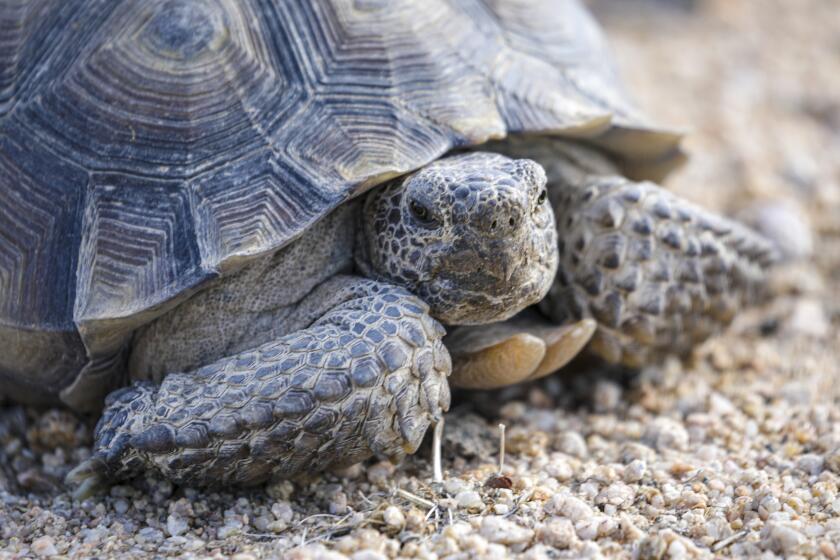Carousel Cowboy : Eric Juarez Rides Herd on the Customers at Santa Monica’s Seaside Merry-Go-Round
Anyone wanting to ride the wooden horses on the Santa Monica Pier has to pass Eric Juarez’s tests first.
When it comes to children, he relies on a line, painted on a post, 42 inches above the ground. He uses it to make sure they’re big enough to ride safely on one of the outside ponies on the pier’s historic carousel.
When it comes to adults, he relies on his practiced eye.
The 71-year-old wooden horses are considered works of art, and if Juarez thinks you weigh more than 200 pounds, you won’t be allowed to mount one.
“If they’re too big, they have to ride in one of the chariots, and nobody likes that very much,” said Juarez, who has been running the carousel for five years. “But most people are pretty good about it.”
Juarez said that although the children like the carousel a lot, “it’s their parents who like it the best. . . . It reminds them of when they were young,” he said. “They tell me, ‘My father used to bring me here.’ ”
Arnold Schwarzenegger and Maria Shriver bring their children to ride the merry-go-round, Juarez said.
“So do Danny DeVito and Rhea Perlman,” added Debbie Mandelkorn, manager of the carousel operation. “And so do Bruce Willis and Demi Moore.”
“The other customers don’t bother them much,” Juarez said. “People come here to ride the carousel, not to look at movie stars.”
With the brightly painted carousel now open seven days a week for the summer, people of all sizes are flocking to the picturesque octagonal building at the foot of the pier.
Although the hours are long and busy this time of year, Juarez, 32 and the father of four, doesn’t mind.
“The view is great--the ocean, the beach, the pier and all the people,” Juarez said. “And it’s nice to see everyone having such a good time, especially the little kids.”
Juarez’s job involves a variety of tasks. When customers stroll into the building, he sells them their tickets--50 cents for adults, 25 cents for children.
As the passengers scramble atop the 44 horses, Juarez checks to see that the safety belts are tightened properly. He uses the line on the post to make sure no small children ride on the outside row--at least, not without an adult standing beside them--out of a concern that they might tumble to the ground. And he escorts the heavyweights to their chariots.
The two inside rows of horses prance up and down, each moved by an overhead crank hooked to the brass supporting pole. The outside row and the chariots are bolted to the floor.
Once the passengers are properly secured, Juarez rings a gong, pushes a button and the 2 1/2-minute ride begins.
“It’s all automatic,” he said. “There’s a timer.”
As the carousel starts to spin, music from an early 20th-Century brass band calliope floods the building.
“It’s so loud that we only use it on weekends,” Mandelkorn said. “There are other tenants upstairs--the city water department, the city’s environmental offices, the pier reconstruction people--so we use quieter music, tapes played on a stereo, during the week.
“There used to be apartments upstairs,” the 37-year-old manager said. “Artistic sorts of people lived up there then, people who didn’t mind the sound of a band nine hours a day.”
As the carousel spun and the riders grinned happily, Juarez and Mandelkorn recounted some of the history of the place, back to about 1875, when Santa Monica’s first substantial pier was built for the unloading of cargo from San Francisco. The construction of Los Angeles Harbor in San Pedro after the turn of the century brought an end to that.
In 1910, William Loof, who had built the nation’s first carousel in Atlantic City, borrowed $5,000 and purchased the land where the old pier had stood. On July 4, 1916, his brand new “Great Loof Pier” opened, and Southern Californians turned out by the thousands to ride the merry-go-round in the big wooden building.
The Loof family sold out in the early 1920s. Next door to the carousel building, the new owners erected the cavernous Santa Monica Ballroom, now long gone.
In the 1930s, visitors bent on a little wicked fun used the pier as a stepping off point to a gambling ship anchored out in international waters, beyond the three-mile limit. During the war years of the ‘40s, the pier fell into neglect.
By 1947, Loof’s original carousel was worn beyond repair, and a search went out for a replacement. It eventually narrowed to “PTC No. 62,” one of fewer than 170 surviving wooden carousels in the United States.
The 62nd merry-go-round built by the Philadelphia Toboggan Co. of Germantown, Pa., it was completed in 1922 under the direction of an artist/engineer named Frank Caretta and set up in Nashville, Tenn.
“He was famous for his carvings of carousel horses and was honored for his excellence,” George McIndoe, a carousel refurbisher, told an interviewer in the 1980s.
“These particular horses were not intended for actual use, but were designed for exhibition purposes,” McIndoe said. “Each one of these horses is valued up to $7,500.”
A deal was struck, and No. 62 was hauled to Southern Santa Monica and set up in the building that had housed Loof’s carousel.
Twenty-six years later, No. 62 won international recognition as part of the background for the Paul Newman/Robert Redford film, “The Sting,” and has since appeared in several other movies and television shows.
At about that time an arsonist set fire to the top floor of the carousel building and the Santa Monica City Council voted to tear down the whole pier and erect in its place a 30-acre island featuring a skyscraper hotel and a small lake.
Outraged citizens forced the council to rescind its vote, however, and the city took over the decrepit pier in 1974. Before the end of the decade, new plans were afoot to convert the white elephant into a cash cow.
In 1986, a $12-million project was begun to restore much of the pier, which had been damaged in the fierce winter storms of 1983. The rebuilding work continues today.
Because of shifting sands beneath the pier, the floor of the carousel building sags perceptibly in several spots. But jacks under the merry-go-round keep the turntable level, and No. 62--refurbished thoroughly during the 1980s--is in every bit as good condition as the day it was built, according to Juarez.
During a break between rides, Juarez showed a visitor the cramped shed in the center of the turntable that houses the carousel’s inner works.
The five-horsepower electric motor that powers the merry-go-round is modern, compact and devoid of character. But the rest of it--the massive gears, bearings, camshafts and cables that suspend and propel the whole apparatus--is a wonder of early 20th-Century mechanical engineering.
“We do maintenance once a week, oiling the bearings and greasing the gears,” Juarez said. “It’s the other part of the job.”
While most visitors to the carousel building come to ride, there are some, like Lisette Van Hemet of Santa Monica, who find it a pleasant place to sit on a bench, contemplate passersby, read a book and watch their children.
Van Hemet brought her son, Jivanto.
“I took him for a ride on the carousel a few days ago, on the six-month anniversary of his birth,” she said. “I could tell he had a good time, ‘cause he smiled a lot.”
Jivanto didn’t say anything, but drooled appreciatively.
Sign up for The Wild
We’ll help you find the best places to hike, bike and run, as well as the perfect silent spots for meditation and yoga.
You may occasionally receive promotional content from the Los Angeles Times.



